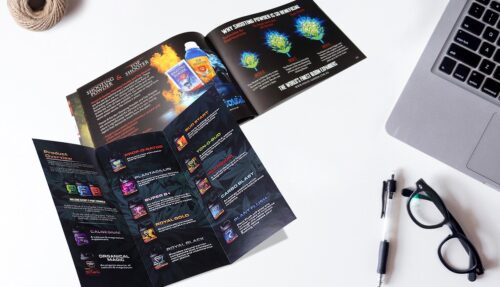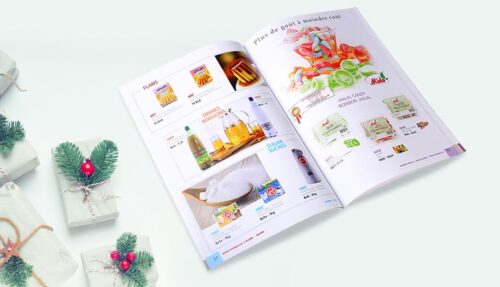How to get the most out of your catalog marketing campaigns

Any business with a wide range of product lines or high-end bespoke services on offer needs a printed product catalog marketing campaign. Even in the Internet age, it remains one of the most effective, valued, and profitable long-term offline marketing strategies in existence.
Back in the 90s, when commerce took its first tentative steps into online retailing, it was fashionable to predict the end of print marketing altogether. But in the same way that the advent of the elevator hasn’t gotten rid of the stairs, online marketing can complement, but hasn’t replaced, offline marketing. And as a recent study published in the Harvard Business Review shows, the product catalog is still valued by customers and effective for business. In fact, a well-designed product catalog can increase turnover by over a hundred percent.
So, let’s take a look at catalog marketing. If it’s your first foray into marketing with a catalog, the following list will help you understand the ways in which you can develop your campaign. If you already have a catalog, the ideas here may spark inspiration for ways to optimize and expand your current marketing successes.
21 reasons to use printed product catalog marketing
1. People love to look at catalogs
An extensive study published by the United States Postal Service (USPS) showed that:
- 60% of online consumers love to get catalogs
- 57% reported browsing a physical catalog before making an online purchase
- 61% of people shopping online said they have the catalog to hand to guide buying decisions
- 84% of those surveyed said a catalog makes shopping easier
People still love the slow, intimate, tactile experience of browsing through a printed catalog. They keep them for months or even years and share them with friends and family. Customers want catalogs and they trust them to guide what they buy, even if they finally make the purchase online.
2. Print catalogs boost online sales
According to the Harvard Business Review, again, a printed product catalog marketing campaign leads to a 125% increase in consumer inquiries. Also, combining an online campaign with a mailed out catalog increases direct sales by 49% compared to campaigns which have only one or the other element.
3. Target your customers at a granular level
If you’re smart, you can use your existing market research data to increase the effectiveness of your printed product catalog marketing campaigns. By splicing your list into demographic segments, you can develop tailored editions of the catalog targeted to specific interests and shopping habits. You can also generate new cohorts of customers by expanding the distribution of your catalogs into novel geographical areas while targeting the recipients based on age, income, hobbies, and other relevant factors.
4. Make lead management and campaign evaluation easy
All marketing campaigns need mechanisms which feed back consumer data so you can evaluate the effectiveness of your strategies. Printed catalogs offer a wealth of opportunities to make it easy to track consumer behavior and trace sales back to their origins. Modern catalogs, for example, can include QR codes. You can also use PURLs (personalized uniform resource locators) for online purchases and unique discount codes that consumers can use on order forms or over the phone.
5. Increase sales by offering multiple purchase options
While all generations enjoy catalogs, and catalogs work to drive online traffic, there’s still a significant chunk of the population that prefers not to shop online. The beauty of the printed catalog is that your customers can choose the buying method which suits them best:
- scan a QR code that takes them to your website to complete a sale
- fill in and send a mail order
- make an order over the phone
- go to your high street store
Breaking down the barriers to purchasing decisions is a key to success. With the printed catalog, you can cover all the options. That way, there’s literally no barrier left.
6. Leverage perceived authority to push up sales
Consumers still perceive the printed page as having more authority than anything published online. A physical catalog lends credibility to your business and increases trust. According to the USPS, browsing a printed catalog generates up to 72% more interest in a business than checking out their website.
7. Build your brand
Repeat exposure is the key to widespread brand recognition. While catalogs have cross-generational appeal, according to studies cited by CNBC, printed product catalogs are most popular with millennials. They love catalogs and often share them with friends and family and even on their social media. So, developing a printed product catalog marketing campaign is a powerful way to increase exposure and brand recognition.
8. Sell more stuff
If you’re in business, you’re in it to make a profit, right? You do that by selling more products. And catalogs definitely help you sell more stuff. Research conducted by the Data Decisions Group and published as a white paper by the American Mailing Association showed that people who receive catalogs spend up to $850 a year buying goods from them.
9. Build a consumer community
These days, it’s all about brand loyalty, belonging, and building a sense of community. Most people, especially in the early twenties to mid-forties age bracket, don’t just want to buy a product. They want to feel that the product expresses something about who they are, their values, and that their buying decisions connect them to a community of like-minded people. By using your catalog to cross-promote your social media — and maybe membership of a private Facebook group, for example — you build a strong sense of belonging and brand loyalty. Consumer communities will go on to do tons of powerful, free marketing for you by spreading the word to their friends and associates.
10. Avoid ad fatigue
“Banner blindness” and “ad fatigue” have been widely studied and are now recognized as established phenomena. In short, the Internet, TV, magazines, and newspapers bombard us with advertising every minute of our waking lives and consumers are finding it exhausting. This is bad news for marketers because consumers tend to either avoid advertisements or mentally “screen them out”. But even though a printed catalog is, in essence, a big collection of product advertisements, that’s not how it’s perceived. A recent study into attitudes to digital advertising showed that people are increasingly suspicious of the ways their data is gathered and used by online marketing campaigns. They are more likely to trust print advertisements and catalogs.
And with regard to catalogs, consumers positively enjoy browsing through them. It’s a relaxing experience which people perceive as safer and less invasive. And even though you are probably gathering data from catalogs, consumers are less concerned about it.
11. Get time on your side
Neilsen research reported by the Marketing Insider Group showed that with digital advertising, you have less than two seconds to harness a person’s attention before they scroll on or click away from your advertisement or promotional content. But as we know, people hold on to catalogs, look forward to reading them, and revisit them over and over. The desperate outbidding for the ever-decreasing attention span of the online consumer means nothing if you have a printed product catalog marketing campaign. Time is no longer your enemy. It’s your best friend.
12. Conquer the coffee table
People are proud of their catalog choices. As you’ve noted already, catalogs are enjoyed as pleasurable experiences. A well designed catalog targeted with care — enriched with beautiful photography, enhanced by a thoughtful layout, and supported by well-written content — often finds its way onto the coffee table. It becomes an inspirational lifestyle symbol and a talking point.
13. Build trust in your online properties
Do you remember that consumers are becoming increasingly suspicious of online marketing? Well, your printed catalog campaign helps break down that barrier. Just so long as your branding is consistent across all media, when your customers move from the offline experience to the online environment, they’ll recognize your brand and carry the trust you’ve built with them offline into your online store.
14. Sell advertising real estate (and get your catalog to pay for itself)
Advertisers are scrabbling for visibility in catalogs these days. According to Statista, ad spend in the catalog space is booming. A wise choice of advertising partners to whom you sell page space could support your business in several ways. With the right partners, you could sell enough advertising to pay for the production of the catalog. All your catalog sales then become pure profit. And you could strike a cross-promotional deal with related businesses to give you even greater outreach into new market segments.
15. Gives you greater control of product presentation
With a catalog, you have complete control over which products are presented to a customer and how. For example, you can highlight your bestsellers to ‘hook’ new customers on your brand. Or, alternatively, you could focus on new product lines to introduce them to the market. Breaking your inventory down into segments promoted by season or offering a special, time-limited discount catalog are all techniques proven to boost sales.
16. Enriched with added content
A catalog needn’t be just an inventory of stock. You can enrich it with magazine-style feature stories, “how to” articles relating to certain products, customer testimonials, behind-the-scenes stories highlighting your business and key employees, a founder history, and so much more. You could even include questionnaires, puzzles, games, and quizzes. This makes your catalog into a valuable asset that people are more likely to keep and share, while also giving you fantastic opportunities to further educate your audience and style your brand.
17. A perfect reason to communicate
If you have a catalog campaign, you have the perfect reason to get in touch with your customers to alert them to new products, special offers, or ask for feedback and reviews. A follow-up letter once they’ve had time to browse the catalog, to thank them for their interest, and to encourage them to get in touch if they have any questions isn’t only good customer service, but good business, too. If you make your catalogs seasonal, then that’s four times a year that you have a valid reason to prompt prospects and remind consumers of your business.
18. From catalog to members-only club
A printed product catalog is a great opportunity to increase engagement and loyalty. It’s an easy step from a catalog to a club. By promoting exclusive content and special deals to catalog club members, along with discounts, cross-promotional offers, interviews, and compelling brand stories, you guarantee that customers feel special and valued and keep coming back to buy more.
19. A picture speaks a thousand words
No matter how high the definition of a digital image — especially if viewed on a phone or tablet screen — it can never compete with the quality and impact of a printed photograph. The most powerful images aren’t just photos of products, but tell a story. They can be of several kinds:
- Contextual — these are images which show the product being used or in an environment in which it might be found.
- Aspirational — as we’ve seen, consumers want more than a product, they want to buy into a lifestyle, a community, an identity. Aspirational images feed that desire and link the product with the dream, whether that’s wealth, a happy family, a beautiful partner, career success, or a relaxing break.
- Sensual — especially powerful with tactile products such as fashion, underwear, and consumables such as food and drinks, sensual images evoke the senses to give an impression of what a product is like to touch, taste, or smell.
- Relational — these are images which show other people engaging with the product. Usually, the people portrayed are those with whom the target consumer can identify, encouraging a sense that the product is right for them.
Recent experiments by major brands with wordless catalogs (Bonobos) and catalogs without published prices (Amazon) have proved very effective. But whether you have text or not, there’s no denying the power of a printed catalog image to attract, engage, and persuade.
20. Ecological and ethical
A recent study reported in Businesswire showed that 85% of consumers globally prefer to buy from a company with a clear sustainability policy and environmentally friendly narrative. Printed product catalog marketing can fit well with your wider green credentials. Catalogs can be printed on FSC certified paper from sustainable forests, be recycled and recyclable, and printed with eco-friendly soy or algae-based inks.
21. Double up with digital, too
Your printed product catalog needn’t be an alternative to your digital campaigns, but it should complement it. When designing your print catalog, although the final product will be produced using offset technology, you’ll usually be able to ask for a digital proof. Get that proof to your developer and with just a few tweaks, you can replicate your physical catalogs online.
A catalog of successes
It’s hard to think of an argument against having a printed product catalog marketing campaign as part of your overall mix. The evidence in favor of the catalog — and the sense of a long and creative future ahead for the medium — is overwhelming. We have decades of experience in supporting businesses to produce their catalogs. Get in touch for a no obligation chat, a quote, or just to find out more. Our expert staff can’t wait to get started on your project. Join our catalog of success stories today!











